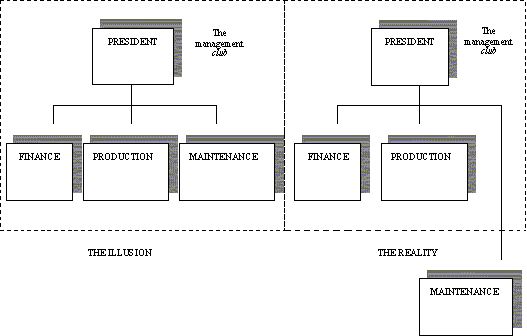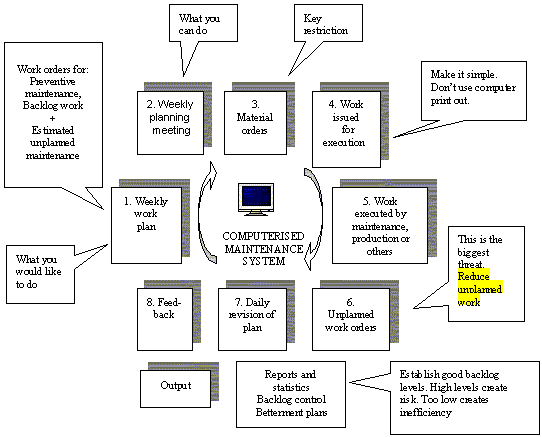|
| Plant Maintenance Resource Center
Maintenance - A Business Centered Approach
| |
|
|
|
|
|
Maintenance - A Business Centered ApproachDuring the early stages of my preparation of this paper, I happened to read a very interesting paper given by Gino Palarchio from Canada who is an active business manager and a director of the Society for Maintenance and Reliability Professionals. He told how he had asked a diverse group of managers from maintenance and production the following question: "What is the first thought that comes in your mind when I mention the word maintenance?" The most common responses that he received were:
These results mirrored my own experiences and they create a sad and dreary snapshot of a critical industrial discipline. A discipline that I love and have dedicated 20 years of my life to. It is clear that maintenance has problems embedded in its history to such an extent that even the word itself has negative and almost Victorian connotations. There is copious evidence that supports this image, for example:
This is hard to reconcile when maintenance is often the major employer of people and can account for up to 40% of total costs in a company. It just does not make sense and more important it cannot be justified.
According to the annual International Competitiveness Report there are significant differences in maintenance effectiveness and individual output between various continents and individual countries. Consultants frequently use 15% as the maintenance cost gap between field leaders and the world average performance. In addition, the average potential for improved production has been estimated at around 6 - 8%. THERE IS NO DOUBT THAT MAINTENANCE REMAINS ONE OF THE VERY FEW BUSINESS AREAS WHERE SIGNIFICANT INCREASES TO COMPANY PROFITS CAN BE ACHIEVED. TYPICAL PROBLEMSDuring my many years in maintenance as an engineer, manager and consultant, I have amassed an enormous amount of reports, statistics and personal experiences relating to maintenance in all types of plants and installations. I now realise that I have been encountering the same six problems, time and time again. These are.
SOLUTIONSWhen I began to analyse these common problems it soon became evident that the solutions are not technical, nor are they particularly difficult to resolve. Further investigation showed that the solution investment versus return scenario could be spectacular. The following are my key success factors for a business based approach to maintenance. 1. Maintenance is not treated seriously at board level or even at local management levelsOf course, many company organigrams show maintenance at the same level as production, marketing, finance etc., but in my experience the reality is more as follows:
The solution is obvious; we have to convince management that maintenance is a key business area. A good starting point would be to read this paper. In my web site there are notes available dedicated to help in the preparation of potential benefit profiles. It won't give you an exact evaluation but it does provide a logical basis to start. One thing is very clear, which is that without top management commitment then major changes are exceptionally difficult to implement successfully. 2. Maintenance lacks a business cultureA maintenance manager can control up to 40% of a company's costs and often has a direct effect on production output. For maintenance to be fully effective then it needs to be a full partner in the business process. The preparation of a maintenance policy and strategy is an excellent start. However, as we have already established, maintenance has a direct effect on company sales, through production, and on costs, which makes maintenance a business centre. In consequence, maintenance needs to develop a cost and income budget with normal forecasting formats, which in conjunction with the other documents will form a maintenance business plan. In this way maintenance will be involved in the management decision process. Routine management reports should focus on department objectives and less on technical detail. Of course, such culture changes are all about changing attitudes and creating the will to do it. Preparing the new document formats is relatively easy and most of the information required is usually already available, if you look for it. I estimate that a business plan and its accompanying documents can be set up in a week and within a few weeks you can have a simple system in place. 3. Maintenance supervision or team leaders lack management skillsSome experts consider that the role of supervisor is the most critical of all roles in industry. The success of companies in today's highly demanding and competitive world depends on the ability to achieve changes at all levels in the organisation. The supervisor controls the key organisational ground that separates management from the workforce, which is fundamental to introducing and sustaining effective change. Unfortunately, many supervisors are given their demanding roles without adequate preparation. Recent studies have shown that industrial supervisors are working at less than 60 % of their potential. Most supervisors are appointed one day and are expected to perform all the complex tasks of management the next day without any form of training or preparation. This is not fair to the individual nor is it an effective strategy for management. We need all the help we can get. We need the supervisors and other team leaders to help us achieve the changes required. So what is the problem and how we can release this enormous potential? The solution is supervisor management skill training, which is one of the most effective elements of an effective maintenance policy and strategy. A well-planned training and career development scheme based on functional skills rather than vocational knowledge only. Programs of this type have immediate and sustainable benefits and should be considered as an investment, and not as a simple cost. The course is designed to improve the performance of front line supervision in the following ways:
Of course, supervisor's job is never going to be 8 to 4 or 9 to 5 and irregular hours and call outs will always occur but regular overtime only achieves short-term gains. These critical 19½ hours could be dedicated to supporting business objectives, which will include optimising productivity. 4. Maintenance is isolated with little integration with other departmentsOf course, maintenance personnel have always had to rely on others to function. Much of the success of these inter-departmental needs have been achieved by long term relationships based on mutual trust and respect. However, we can all recall examples of poor co-operation and even conflict, which has had adverse effects on overall progress. In many companies the relationship between maintenance and operations is close to open warfare. The following chart shows the level of direct control that maintenance has.
This clearly demonstrates that maintenance must take full responsibility for its internal management but it cannot reach anywhere near its full potential without attending to the 46% element that needs the positive assistance of other departments. It is also clear that management is closely inter-related with each and every activity on the chart if work is carried out effectively. Although good will is an essential ingredient in any relationship it is not enough on its own to sustain an ongoing integrated strategy. An excellent method of developing practical and effective integration between different groups is the alliance approach. An alliance is a formal agreement to work together with common objectives and approved procedures. Another excellent integration method is to implement an equipment care program, which involves operations personnel and others in performing routine checks and basic tasks. It seems ridiculous to me that a mechanic has to check oil levels when there are operators in constant attendance. You don't take or car to a mechanic to check your oil levels, so why not treat company assets in the same way. 5. Low levels of planned maintenanceEach of the six key success factors of is important, but of course some things will always be more critical than others will. Of all the factors listed the planned maintenance is the most important of all. Planned maintenance is not just preventive maintenance but any type of maintenance that has been planned in advance such that production output is optimised, equipment is protected and maintenance resources are effectively used. I believe that our emphasis on preventive versus corrective maintenance can be misleading and will not always provide accurate system performance data. For example, planned corrective maintenance can be very cost effective, in many cases. PMMS (Planned Maintenance Management System)
The best approach to planned maintenance is to purchase a computerised maintenance system. These are readily available and are relatively cheap. This system will be the heart of our new system but it will not actually do the maintenance all on its own. This seems to surprise some people! The following flow chart shows the interrelationship between a computer system and the essential procedural elements. The careful preparation of these interrelating procedures will be critical to the success of the new integrated maintenance system. Computer output is excellent for trained personnel but it is not user friendly for those who do the work. An excellent method to consider is a card system, which has a proven success record, working alongside the computer system.
6. Preoccupation with advanced maintenance methods, which fail due to a lack of basic practicesI cannot remember the number of times when visiting maintenance offices that I have seen expensive condition monitoring equipment gathering dust on top of cupboards. No doubt, these were bought in good faith but they failed due to the lack of basic maintenance practices. The solution is simply to establish an effective planned maintenance before ever thinking of more sophisticated methods. An even better approach would be to develop and establish the five key success factors above first. It is important to say that it is not my intention in any way to devalue the contribution of advanced approaches of maintenance, as there is voluminous evidence of the success of TPM, RCM and other such systems. I simply believe that their success depends on getting the basics right first. COMMENTThis paper concentrates on how to resolve these six key success factors. Of course, I realise that many companies have developed good modern maintenance systems and may feel that this six success factor approach is an over simplification that will have little value to their future development. However, in my experience there are not many companies that have successfully achieved all the benefits that are available. Chris Thomas
For more information visit the Chris Thomas Asociados web site at http://www.espania-spain.com/cta
Copyright 1996-2009, The Plant Maintenance Resource Center . All Rights Reserved.
| ||||||||||||||||||||||||||||||||||||||||||||||||||||||||||||||||||||||||||||||||||||||||||||||||||||||||||||||||||||||||||||||||||||||||||||||||||||||||||||||||||



